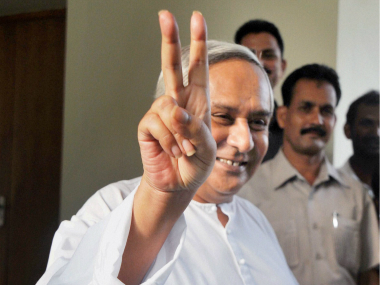By Thilak A Anti-incumbency, like gravity, is a hard thing to fight. Incumbent Chief Ministers, no matter how popular, have to dive into the electoral math and see what configurations will work to achieve victory. Naveen Patnaik followed two primary strategies to sweep 20 of the 21 seats in Orissa to win big. The two strategies were primarily this. One, If voters need a change & are angry at the incumbent, then why can’t the alternative be from your own party? Patnaik executed on that strategy by denying tickets to 6 sitting MPs. Two, making the BJP wave & smaller opposition vote work in his party’s favour by allowing it to split each other’s vote. [caption id=“attachment_1532505” align=“alignleft” width=“380”] Naveen PAtnaik flashes the victory sign after winning the Lok Sabha elections. PTI[/caption] Strategy 1: Counter Anti-Incumbency by Switching Sitting MPs If you compare the 14 seats that BJD won in 2009 and 2014, you will find that the constituencies where the MP was switched (Aska, Jajpur etc) had less negative vote swings and more positive swings than where the incumbents remained in place (Berhampur, Bhubaneswar). Switching incumbents increased vote share by a large amount in places like Mayurbhanj & Kandhamal which improved BJD’s state wide vote share rankings from 37 percent (2009) to 43.3 percent (2014) & beat exit poll projections by 6-8 percent. Constituencies such as Bhubaneswar, Cuttack and Dhenkanal, where the incumbents were not switched, all had massive margins in 2009 and could withstand negative vote swing shocks from a BJP wave & still win. Strategy 2: Make the BJP resurgence & smaller parties work in your favour by splitting opposition vote Bargarh, Jagatsinghpur, Kalhandi, Sambhalpur & Bolangir were all cases were there was a big resurgence in BJP’s favour but ended up splitting Congress’ vote share. For example, in Bolangir, where the 2009 margin wasn’t that big (9 percent), the incumbent Kalikesh Narayan Singh Deo was in a pitched battle with a family member Sangeeta Kumari Singh Deo. This big BJP resurgence ended up eating Congress vote share & delivering the same 9 percent margin victory as 2009. In Bargarh, where the winning margin was only 1 percent, other smaller parties such as Paschimanchal Vikas Party (2.3 percent vote share) & AAP (1.4 percent vote share) ended up helping the BJD overcome the opposition. Three seats (Bargarh, Kalhandi & Sambhalpur) were pickups from the INC & Jagatsinghpur was with the left in 2009 & now won the by the BJD. In the fifth constituency of Nabarangpur, which was a BJD pick up from INC, the margin was less than .2 percent (about 2000 votes). In this case Odisha Jan Morcha got 2.4 percent & Aama Odisha Party got 1.8 percent of the vote share & ended up splitting opposition votes. The Odisha Jan Morcha was led by former senior BJD leader, Pyarimohan Mohapatra. He resigned from the BJD after a bitter fight with Naveen Patnaik. Ironically, his presence ended up splitting Congress votes & giving an additional seat to the BJD. Thilak is the product manager and senior data analyst at Vozag.com, a quantitative and data analytics research helping consumers make better decisions. They developed a database of polls of Indian elections as a side project to understand the data behind the elections.
Naveen Patnaik followed two primary strategies to sweep 20 of the 21 seats in Orissa to win big. One was to switch MPs to fight anti-incumbency, the second was to use the BJP wave in his favour.
Advertisement
End of Article
Written by FP Archives
see more


)
)
)
)
)
)
)
)
)



